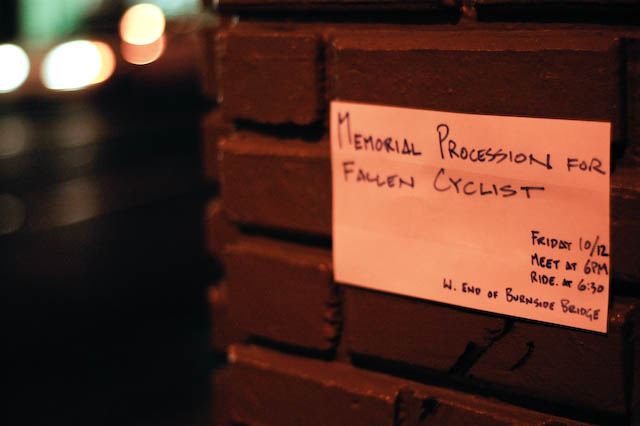With all the discussion going on about how to make bike travel safer on crowded downtown streets, I thought we should take a closer look at some of the options on the table.
The first one has to do with signage and how legislation, enforcement, and engineering deal with non-motorized vehicle travel lanes (previously known as bike lanes).
According to the law, a bicycle is a vehicle. So, it seems to follow that a bicycle lane should be considered (in the eyes of engineers and law enforcement professionals) as a vehicle travel lane, on par with motor vehicle travel lanes.
In the case of SW 14th and Burnside, where Tracey Sparling and a cement truck collided on Thursday, there were two vehicle travel lanes involved: one of them was a motor vehicle lane, the other was a non-motorized vehicle lane.
Here are the signs hanging across W Burnside. This is close to the view the cement truck driver would have had as he waited at the red light (I apologize for the poor quality):

Each of the three motor vehicle travel lanes have dedicated signage telling them what type of movement they can and should make.
However, the non-motorized vehicle lane has no signage. Also, there is no explicit warning on the motor vehicle lane signs that there is another vehicle travel lane at this intersection. This fact, along with several others, created a situation where Tracey Sparling was invisible to the driver of the truck.
Do you think a sign like the one below would increase safety at intersections like this?
I realize signs have limitations in their effectiveness and they are not the only answer to increasing safety. However, it seems if we are going to respect bicycles as vehicles in the law, and we are going to continue to use and maintain bike lanes downtown (some folks think we’d be better off without them, but that’s another post), then it seems we should give their travel lanes the same respect as motorized vehicle lanes in all other facets of our street engineering.
What do you think?
[Please note: I am not a bike planning or engineering expert and I am not saying that a sign would have saved Sparling’s life. The intent of this post is to promote a discussion of signage and how treatment of vehicle travel lanes differs between cars and bikes.]
Depending on the response to this post, I’d like to continue the “Safer Streets” series to explore other ideas like; bike boxes, the California bike lane law (proposed by the Police Bureau), removing bike lanes downtown, early-phase signals for bicycles, equipment requirements on trucks, and any other idea that rises to the surface.


